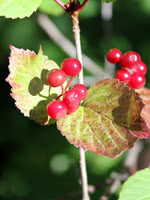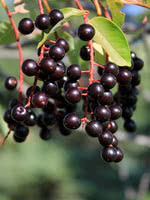Mon-Fri 9am - 5pm Mountain time
Western Chokecherry vs Lowbush Cranberry
Viburnum edule
Prunus virginiana var. demissa
NOT AVAILABLE THIS SEASON - MIGHT RETURN
SOLD OUT
Lowbush Cranberry is a short, deciduous shrub native to North America. Its white flowers bear sour but edible fruit that ripens to a brilliant red in fall. Lowbush Cranberry's small size makes it suitable for urban use; buyers will also find it useful if trying to reclaim land back to its original species or when landscaping with native species in damp conditions.
Western Chokecherry is a shrub or small tree commonly used for farmstead and field windbreaks.
It produces white flowers in the spring and edible dark purple fruit that matures between September and October. Its cherries are great for making for making jams, jellies or wine, but are not very palatable for raw eating.
Lowbush Cranberry Quick Facts
Western Chokecherry Quick Facts
Toxicity: toxic to horses, cattle, etc.)

